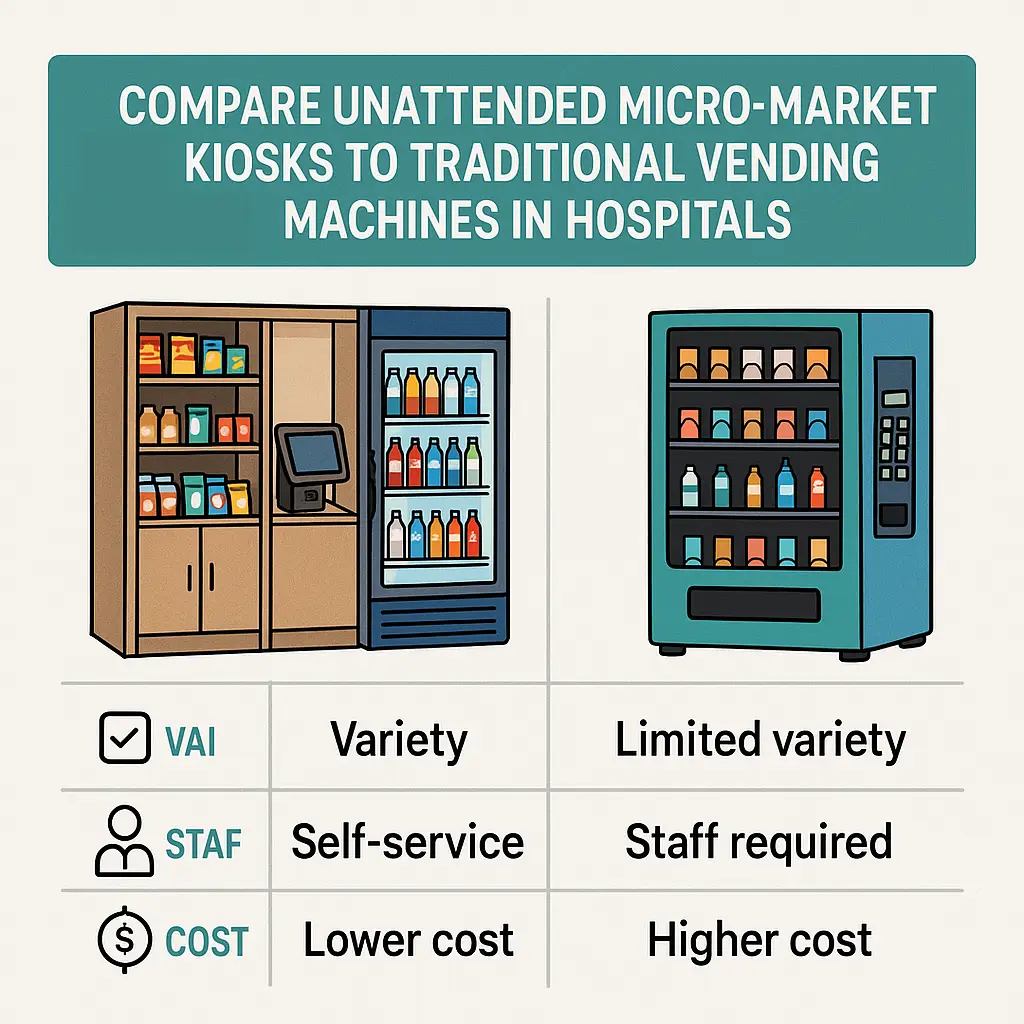Micro Markets vs Vending Machines in Hospitals
Compare unattended micro-market kiosks to traditional vending machines in hospitals for variety, staffing, and cost.
Back to Vending for Healthcare ResourcesCompare unattended micro-market kiosks to traditional vending machines in hospitals for variety, staffing, and cost.
Back to Vending for Healthcare ResourcesMicro markets provide self-service kiosks with fresh food and drinks, while vending machines deliver a smaller, low-maintenance option focused on packaged items and compact installation.
![]() Micro markets expand variety with fresh meals and snacks
Micro markets expand variety with fresh meals and snacks
![]() Vending machines offer cost-effective and compact solutions
Vending machines offer cost-effective and compact solutions
![]() Contactless payment enhances safety and convenience
Contactless payment enhances safety and convenience

Hospitals operate around the clock, making it essential to provide staff, patients, and visitors with reliable food options. Traditional vending machines have long been a fixture, offering packaged snacks and beverages in compact, unattended formats. Micro markets, however, are becoming more common, delivering an expanded variety of fresh food choices through open-shelf kiosks and self-checkout technology. Understanding the advantages of each approach helps facilities design food access strategies that meet diverse needs while keeping operations manageable.
One of the biggest advantages of micro markets is variety. They allow hospitals to stock fresh items such as salads, sandwiches, yogurt, and even full meals. This is especially helpful for employees working long shifts who want options beyond snacks or soft drinks. Micro markets also support contactless payment systems, improving speed and hygiene. However, they typically require more floor space, higher installation investment, and regular oversight to ensure fresh products are rotated properly.
Vending machines remain the more compact and cost-effective option for many hospitals. Their footprint is small, making them ideal for hallways, waiting areas, and breakrooms with limited space. Machines are low-maintenance, require less staff oversight, and provide consistent service 24/7. While the variety is narrower compared to micro markets, vending machines now often include healthier options and energy-efficient designs. Some advanced models integrate real-time tracking and smart payment features, keeping pace with modern expectations.
Hospitals weighing the decision between vending machines and micro markets should consider several factors: available space, budget, staffing, and the importance of fresh product offerings. In smaller facilities or areas with limited traffic, vending machines are often the better fit. In high-traffic areas, especially where staff need meal replacements during long or overnight shifts, micro markets can provide valuable variety and satisfaction.
For related insights, explore how different vending types support hospital needs or learn more about sanitation and compliance standards in healthcare vending. Both topics provide helpful context when planning long-term food service strategies.
If you're exploring vending options for your business, Vending Exchange can help simplify the process. Delivery, Installation and Equipment is provided at no cost to you - vendors provide the machines, keep them stocked, and handle all servicing. Whether you need a provider or full-service management, just fill out the form on this page to get started.
Micro markets offer fresh food and open-shelf selection, while vending machines provide compact, packaged snack and drink options.
Yes, micro markets require more floor space for shelving, refrigerators, and self-checkout stations compared to compact vending machines.
Yes, vending machines remain valuable for limited-space areas and provide reliable, low-maintenance access to packaged items 24/7.
Micro markets often provide healthier and fresh options, though vending machines can now be stocked with better-for-you packaged products.
Yes, vending machines are typically lower-cost to install and operate, while micro markets require higher upfront investment and regular oversight.
Yes, modern vending machines and micro markets both support contactless and mobile payment systems to improve convenience and hygiene.
Micro markets are helpful for longer shifts requiring full meals, while vending machines are reliable for quick snacks and drinks at any hour.
Hospitals or operators must regularly rotate stock and monitor expiration dates to ensure food safety in micro markets.
Yes, vending machines require less oversight since they dispense packaged goods and have simpler service needs.
Yes, many facilities install a mix, using vending machines in smaller areas and micro markets in high-traffic staff zones.